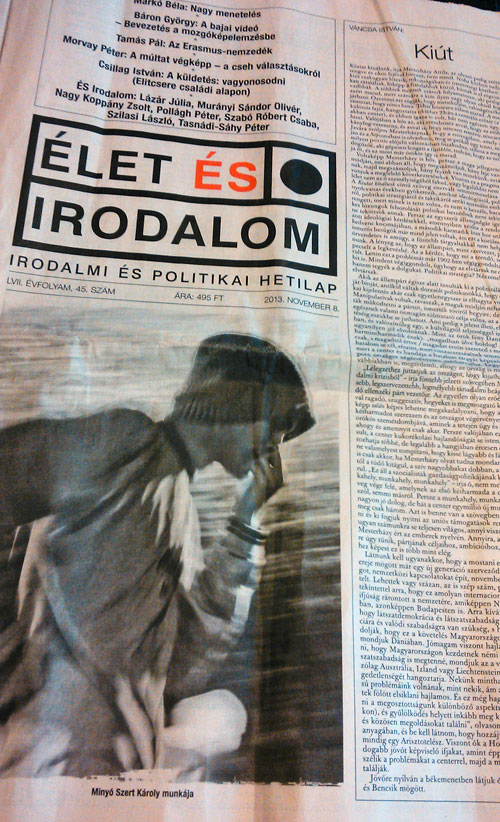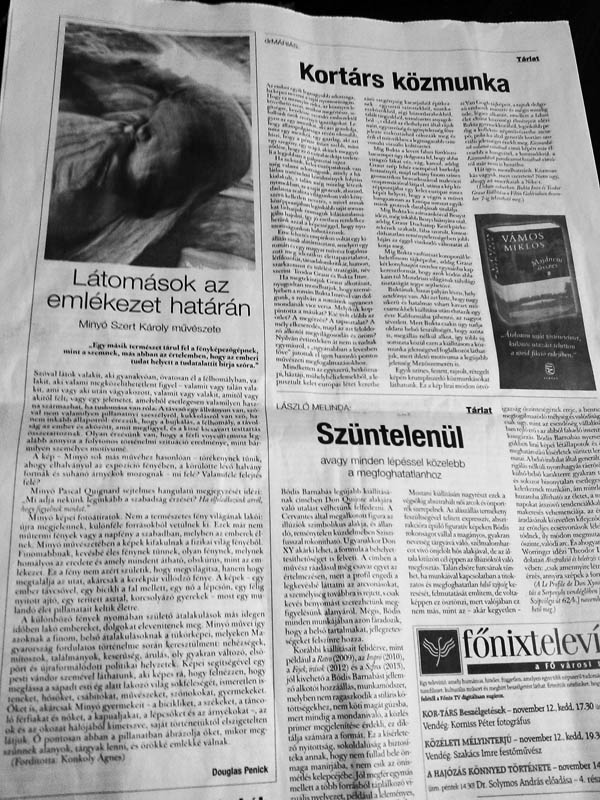Douglas Penick - Visions at memory's edge
VISIONS AT MEMORY'S EDGE:
THE ART OF KAROLY MINYO SZERT
(Details of the essay)
Douglas Penick
"It is another nature that speaks to the camera than the eye; other in the sense that a space
informed by human consciousness gives way to a space informed by the unconscious."
-Walter Benjamin, A Small History of Photography. (tr.Kingsley Shorter, p.243 ONE
WAY STREET- Verso Editions, 1979)
...I looked at the man with the telescope, as he stares at something or someone,
his hand in his pocket, maybe moved to desire, maybe jingling coins, the more deeply
moving I found this picture. Minyo had given me a hint. "It is a unique picture." he said,
"and a uniquely Eastern European image."
So I see someone living warily in half-light, someone who is looking at something
inaccessible- perhaps at something or someone longed for, something or someone feared,
or a scene that offers some other possible advantage to know of.
The telescope is on a stand, so this is not a momentary whim of voyeurism. It's a more
permanent condition: the hiding, the half-light, the distance between the man and what he
looks at, the slightly contorted posture the man must assume: they are interlocked. There
is a feeling that the man's voyeurism is as much the result of a continuous historical
situation as of any personal motive.
And in this, as in many of Minyo's pictures, the image itself appears vulnerablevulnerable
to disappearing in the light of exposure and surrounded by faint shapes and
encroaching shadows moving towards- what? A kind of oblivion?
Altogether, Minyo here evokes the shadowed atmosphere of Pascal's Quignard's remark:
"What most gives us the sense of liberty? Forgetting that you are being watched."
(Pascal Quignard- The Silent Crossing, tr. Chris Turner, Seagull Books, 2013- p.131)
Then, to the guitar music of a raddled but adroit old hipster, Minyo rides his well-known
stationary bicycle in the darkened gallery, using the headlight to project an image onto a
specially prepared canvas. He then develops the picture. The light comes on, and there is
a new image. Or rather, an old image reappears from nowhere as a bicycle rider pumps
the pedals in the dark to power the little lamp. It is cumbersome and humble magic.
Minyo's pictures are transpositions of photographs. In his paintings, images no longer
inhabit the world of natural light; they re-appear, projected from a different source. It is
no longer the light of the studio or the outdoor sun in which the figures live. In Minyo's
art, images fade from the light of the physical world. They now appear in a gentler, less
critical light, a light with no clear origin, a light as pervasive and oblique as memory. This
is light manufactured not to illuminate but to find the way like the flickering of a bicycle
light. The images: a man at a telescope, a bicycle by a wall, a woman on a staircase, a
door half open, a table waiting for guests, children skating, now reveal a more fragile life.
The transformations produced within this different light reveal people and things now
dwelling in different, stranger time. Minyo's work thus echoes the subtle inner changes
wrought by Hungary's shifting history, a history of hardship, myths, inventions,
bitterness, betrayals, so often redirected, erased and reshaped in the hard flattened gaze of
political moment. His pictures allow us to look on the images he presents much as a
wanderer in Pest who chances to look up, sees ranged against the pale evening sky rank
upon rank of unknown gods, heroes, seductresses, artists, orators, children. Like them,
Minyo's children, bicycles, chairs, men and women dancing, door-ways, stairs and
shadows are isolated from their history, from cause and effect. He shows us these things
at the very moment they are disappearing as objects in the world and becoming, forever,
memories.
Douglas Penick Bio:
Douglas Penick was a research associate at the Museum of Modern Art, NY and at the Institute for Architecture and Urban Studies. He wrote the Canadian NFB’s series on the Tibetan Book of the Dead (Leonard Cohen, narrator) and libretti for two operas: King Gesar (Sony CD w/ Ma, Serkin, Ax, etc.) and Ashoka’s Dream (Santa Fe Opera) with Peter Lieberson. He's received grants from the Witter Bynner Foundation for Poetry, the Graham Foundation, and the Dru Heinz Foundation for a NY Philharmonic commission In addition to three book-length episodes from the Gesar Epic, many short pieces have been published in the US, Canada, Malaysia, the UK, France, the Czech Republic, Germany and Australia (including Cahiers de L'Herne, Parabola, Bombay Gin, Agni, Hyperallergic, Descant, BODY, Tricycle, Regnum Sacrum). His novel about the 3rd Ming Emperor, A Journey of the North Star was brought out by Publerati last year. His novel, Dreamers and Their Shadows about spiritual seekers and their labyrinthine yearnings, appeared early this summer.
Douglas Penick Website

